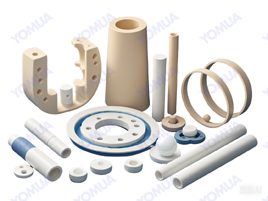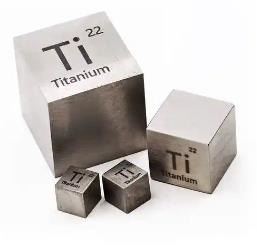Zirconia Ceramics (ZrO2) and Titanium Alloys are both advanced materials widely used in industries such as aerospace, medical, and automotive due to their unique properties. However, they have distinct characteristics that make them suitable for different applications. Below is a detailed comparison of the two materials:

1. Mechanical Properties
| Property | Titanium Alloys | ZrO₂ Ceramics |
|---|---|---|
| Density | Low (4.4–4.8 g/cm³) | Higher (5.6–6.0 g/cm³) |
| Strength | High tensile strength (800–1200 MPa) | High compressive strength (2000 MPa) |
| Toughness | Excellent (high fracture toughness) | Moderate (brittle, but higher than other ceramics) |
| Hardness | Moderate (HV 300–350) | Very high (HV 1200–1400) |
| Elastic Modulus | Low (110–120 GPa) | High (200–210 GPa) |
Key Points:
- Titanium alloys are lightweight and have excellent toughness, making them ideal for structural applications.
- ZrO₂ ceramics are harder and more wear-resistant but are brittle compared to titanium alloys.
2. Thermal Properties
| Property | Titanium Alloys | ZrO₂ Ceramics |
|---|---|---|
| Melting Point | High (~1660–1670°C) | Very high (~2700°C) |
| Thermal Conductivity | Low (7–12 W/m·K) | Very low (2–3 W/m·K) |
| Thermal Expansion | Moderate (8.6–9.7 µm/m·K) | Low (10–11 µm/m·K) |
| Thermal Shock Resistance | Good | Excellent (due to low thermal conductivity) |
Key Points:
- ZrO₂ ceramics have a much higher melting point and better thermal shock resistance, making them suitable for high-temperature applications.
- Titanium alloys have better thermal conductivity, which is useful in heat exchange applications.
3. Corrosion and Wear Resistance
| Property | Titanium Alloys | ZrO₂ Ceramics |
|---|---|---|
| Corrosion Resistance | Excellent (resists acids, alkalis, and seawater) | Excellent (chemically inert) |
| Wear Resistance | Moderate | Excellent (high hardness and low friction) |
Key Points:
- Both materials are highly corrosion-resistant, but ZrO₂ ceramics are superior in wear resistance due to their hardness.
- Titanium alloys are more prone to wear in abrasive environments.

4. Biocompatibility
| Property | Titanium Alloys | ZrO₂ Ceramics |
|---|---|---|
| Biocompatibility | Excellent (widely used in medical implants) | Excellent (used in dental and orthopedic implants) |
| Osseointegration | Excellent | Good |
Key Points:
- Both materials are biocompatible, but titanium alloys are more commonly used in load-bearing implants due to their toughness.
- ZrO₂ ceramics are preferred in dental applications due to their aesthetic appearance and wear resistance.
5. Electrical Properties
| Property | Titanium Alloys | ZrO₂ Ceramics |
|---|---|---|
| Electrical Conductivity | Moderate (conductive) | Insulator (very low conductivity) |
| Dielectric Properties | Not applicable | Excellent (used in insulators and capacitors) |
Key Points:
- Titanium alloys are conductive, making them unsuitable for electrical insulation.
- ZrO₂ ceramics are excellent insulators and are used in electronic and electrical applications.
6. Cost and Manufacturing
| Property | Titanium Alloys | ZrO₂ Ceramics |
|---|---|---|
| Cost | High (expensive raw materials and processing) | Moderate (lower than titanium alloys) |
| Manufacturing Complexity | High (difficult to machine and process) | Moderate (easier to sinter but brittle) |
Key Points:
- Titanium alloys are more expensive due to the cost of raw materials and complex machining processes.
- ZrO₂ ceramics are cheaper to produce but require specialized sintering techniques.
7. Applications
| Application | Titanium Alloys | ZrO₂ Ceramics |
|---|---|---|
| Aerospace | Structural components, engine parts | Thermal barrier coatings, sensors |
| Medical | Implants, prosthetics, surgical tools | Dental crowns, orthopedic implants |
| Automotive | Engine components, exhaust systems | Sensors, wear-resistant parts |
| Industrial | Heat exchangers, chemical processing | Cutting tools, insulators, bearings |
| Electronics | Limited (due to conductivity) | Insulators, capacitors, sensors |
Key Points:
- Titanium alloys are preferred for structural and load-bearing applications.
- ZrO₂ ceramics are used in high-temperature, wear-resistant, and insulating applications.
Conclusion
- Titanium Alloys are ideal for applications requiring high strength, toughness, and lightweight properties, such as aerospace and medical implants.
- ZrO₂ Ceramics excel in high-temperature, wear-resistant, and insulating applications, such as thermal barriers, dental implants, and cutting tools.
The choice between the two materials depends on the specific requirements of the application, including mechanical, thermal, and environmental factors. Both materials offer unique advantages and are often used in complementary ways across industries.